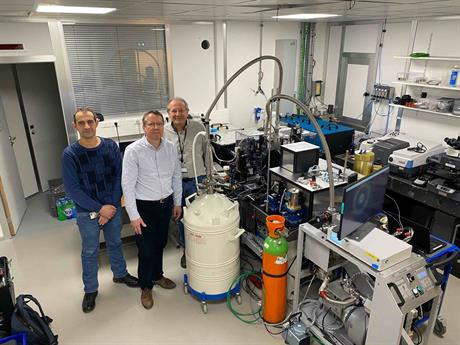A long-standing issue in Physics
The existence of metal-phase hydrogen was predicted more than 80 years ago, sparking a race to observe it ever since within the high-pressure physics community. While there have been many claims of proof in recent years, none have managed to convince the scientific community.
The result of many years of research
The insulator–metal transition of hydrogen has now been observed thanks to a combination of the CEA DAM's high-level expertise in extreme pressure physics and the use of a major research facility, the SOLEIL synchrotron. The development of a new kind of diamond anvil cell that can exert over 4 million times the Earth's atmospheric pressure, together with the non-intrusive measurement of the insulator-metal transformation using very bright infrared radiation produced by the synchrotron, able to probe a sample measuring only a few microns in diameter, allowed the researchers to observe the transition to the metallic phase, detect the signature of the sample's metallic profile under pressure and, with minute precision, identify the pressure at which transition occurs. Their results are the outcome of many years of research entailing constant advances in diamond anvil cell technology and in experiments using such large instrumentation.
A question of fundamental interest
The simplicity of hydrogen (the first atom in the Periodic Table, made up of one proton and one electron) has played a key role in the development of modern physics. At the beginning of the 20th century, Quantum Mechanics led us to understand the properties of the hydrogen atom, and then of the dihydrogen molecule (H2). However, producing an accurate description of its behavior under pressure that would provide data on the hydrogen phase diagram, in other words, knowledge of the hydrogen state at different pressure and temperature levels, entails extremely complex computations and experiments. The data obtained are a world first and will be used to advance theoretical models.
A wealth of exciting possibilities
Far from closing the case on a fundamental question that has fascinated scientists since it was first posited decades ago, this observation paves the way for many exciting possibilities. To begin with, it will be used to establish a benchmark for validating theoretical approaches to calculating the properties of very dense hydrogen at the center of giant planets, or for nuclear fusion by inertial confinement fusion. Certain properties that are as unexpected as they are spectacular have already been computed for metallic hydrogen, such as being a superconductor at room temperature, having an extremely mobile proton, and the ability to transform from solid to liquid state at very low temperature. This initial observation using a device able to obtain samples of metallic hydrogen that are large enough for detailed characterization is a springboard that will reveal all the properties of this metal. It can then be used in experimental research to measure the potential superconductivity of this metal: if metallic hydrogen can be demonstrated to be a superconductor at ambient temperature and pressure, that would be a major breakthrough in the field of hydrogen storage, which is key to ensuring our future energy needs. The prospects of such advances may as yet seem beyond our reach in the case of pure hydrogen, but the idea of synthesizing it with other metals in alloy form looks very promising. The team's initial results in synthesizing super-hydrides, such as FeH5 and LaH10, are very encouraging.

From left to right: Florent Occelli, Paul Loubeyre and Paul Dumas© Synchroton SOLEIL
Shared expertise
This success was possible thanks to the pooled expertise of three specialists in their fields. Paul Loubeyre and Florent Occelli, at the CEA, contributed all their knowledge of manufacturing and optimizing high pressure cells to achieve to the extreme conditions required. They are internationally-recognized for their research relating to such instrumentation. Paul Dumas, Emeritus Research Director at the CNRS, on secondment at the Synchrotron SOLEIL facility, is renowned throughout the international scientific community for his expertise in the use of synchrotron radiation in the infrared domain, the kind of radiation used to reveal the metallization of hydrogen.